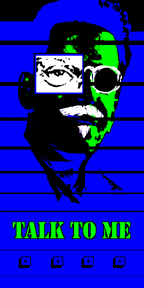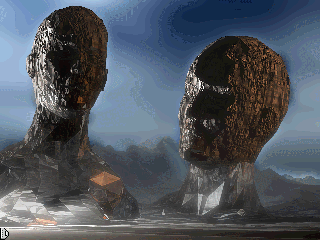TALK TO ME
An interactive computer audio installation

Art director Douglas-Scott Goheen's design
for the exterior of Talk to Me
Computer audio programming and composition: Christopher Dobrian
Computer animation programming and design: Daniel Beck
Installation art direction: Douglas-Scott Goheen
Additional audio effects design: Benjamin Israel
Installation fabrication: Gordon Richins

Excerpt from the computer animation
created by Daniel Beck for Talk to Me
Electronic media have drastically altered the definition of communication. In today's society, people regularly "converse" with voicemail recordings, couples sit together in restaurants each engaged in a cellular phone conversation with a distant person while ignoring each other and their surroundings, and some people have even redefined "sexual relations" to include typing on a computer terminal to a virtual partner in a cyberspace chat room.
Talk to Me evokes some of the alienation and disconnection associated with contemporary communication. A vaguely menacing big-brother image cheerfully invites passersby to "Talk to me," while in his eye we see images of quiet human desperation juxtaposed with impersonal technology. When one talks to the image, instead of an intelligent discourse, one hears an insensitive response consisting primarily of electronically altered versions of one's own voice. The technology has a certain "awareness" and "personality" of its own, but provides a rather dissatisfying version of interaction.
At the same time, Talk to Me explores a novel kind of human-computer interactivity, in which sound is the only means of human user interface. The resulting sound is a composed/improvised sound/music collage of sounds the computer has perceived from its surroundings.

Excerpt from the computer animation
created by Daniel Beck for Talk to Me
Talk to Me is a social "improvisation" between a computer and its human interlocutors. The computer's behavior is modeled on the degrees of interaction (and alienation) an individual may experience in a culture of predominantly electronically-mediated communication. The computer listens to sounds in the world around it, stores and processes those sounds, and contributes its own ideas in response (although its own "ideas" are always merely a recombination and varied restatement of the information it has received from others.)
In this model of behavior, the computer has three modes of discourse: interactive, solitary, and invitational. When it senses sounds around it, it behaves in its social "interactive" mode, reacting visually and sonically to the sounds it hears and modifying them on an ongoing basis. When it senses that it is not engaged in dialog, it behaves in "solo" mode, developing and expounding upon ideas heard earlier. When it is left alone for a long period it enters "invitation" mode (it "gets lonely", as it were), and begins to entice passersby to engage in conversation.
This social metaphor can also be viewed as a formal structure for a musical improvisation. The sounds and animations can be appreciated simply as a visual/musical experience which varies continually and can be actively (and interactively) influenced by its listener(s). Sounds introduced by the listener immediately influence the structure of the music, and are incorporated as musical material for future improvisation.

Example of the sound-processing programs
written by Christopher Dobrian for Talk to Me
The interactive operating system, audio processing, and musical composition were programmed in the Max/MSP programming environment on a Macintosh computer. Additional audio effects are applied using a Digitech TSR24S processor controlled by the Macintosh. The animation is programmed in the Director/HyperMIDI environment on a second Macintosh computer, which receives information from the first computer regarding the perceived sounds, and uses that information to influence the onscreen image.

Explanation of the computer operations
programmed by Christopher Dobrian for Talk to Me
You can download an audio excerpt that gives some idea of the audio processing that occurs in "Talk to Me".
The artists wish to thank Dr. Jill Beck, Dean of the UCI School of the Arts, for her encouragement and assistance in the realization of this project.
Christopher Dobrian is Assistant Professor of Music at UCI, and is the Director of the Gassmann Electronic Music Studio. He is a composer of instrumental music and computer music involving artificially intelligent musical behavior. He is vice-president of the Electronic Music Foundation, and the author of the technical documentation and tutorials for the Max and MSP programming environments used for the audio programming in Talk to Me.
Daniel Beck is a Chicago-based artist specializing in computer animation and video. He holds an M.F.A. from the Rensselaer Polytechnic Institute, and is currently manager of media development for Prentice-Hall publications. His collaboration in this project was conducted entirely via the Internet.
Douglas-Scott Goheen is Professor of Drama at UCI. With extensive design credits in every medium of the performing arts, he has designed acclaimed and unique stage settings in a rich variety of production venues in the United States, Latin America and Europe. Comfortable with the realities of electronic, commercial, and popular entertainment design, he nonetheless specializes in working with "arte-povera" theatre groups that Eugenio Barba calls, "the outlying zones of planet Theatre--groups that autonomously construct meaning that ignores the boundaries assigned to our craft by the surrounding culture. "
Benjamin Israel is a second-year graduate student in Music Composition, specializing in computer music and music for dance.
Gordon Richins is a third-year graduate scenic design student whose thesis project will be the stage design for "Oklahoma" at the Irvine Barclay Theatre in April 1999.




